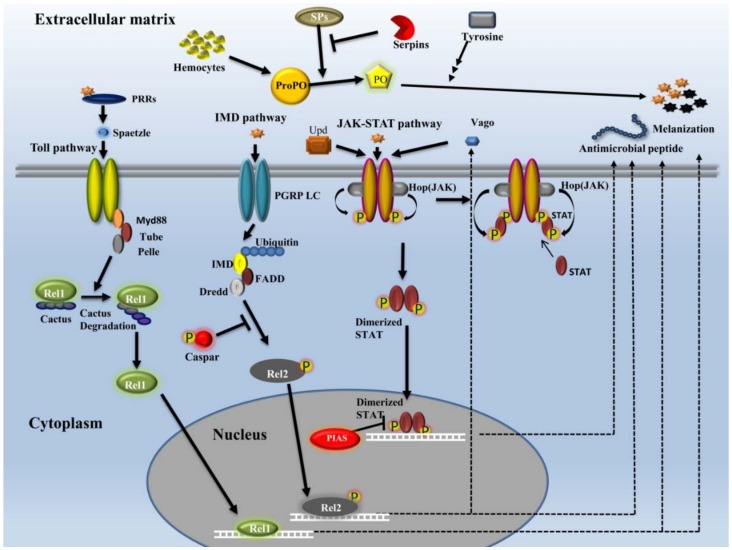Figure 2.
The signaling pathway of mosquito’s innate immunity. Recognition of pathogen-associated molecular patterns by pattern-recognition receptors (PRRs) activates the Toll pathway by proteolytic cleavage of spaetzle which binds to Toll receptors and triggers the signalling through adaptor proteins. This results in phosphorylation and degradation of the Cactus protein, which is an inhibitor of Rel1. Degradation of Cactus allows Rel1 to be translocated to the nucleus for the activation of transcription of genes regulated by Toll pathway. The IMD pathway is triggered by the binding of pathogens with PGRP-LC, which further triggers the signalling through IMD, FADD, and Dredd. This results in the phosphorylation of Rel2 by the activity of the Dredd protein. This step is regulated by the Caspar protein which is a negative regulator of the IMD pathway. Now Rel2 enters the nucleus to regulate the transcription of IMD-regulated genes, which are also involved in the synthesis of antimicrobial peptides. The JAK-STAT pathway is triggered by the binding of Upd with receptor proteins (Dome), leading to the activation of Hop proteins. Activated Hop proteins phosphorylate each other and STAT proteins, which are dimerized upon phosphorylation. This dimer of STAT proteins translocates to the nucleus and activates the transcription of JAK-STAT regulated genes, some of which are involved in the synthesis of antimicrobial peptides. PIAS is a negative regulator of dimerized STAT proteins inside the nucleus, and over-expression of PIAS inhibits JAK-STAT signalling pathway. Melanization is triggered by the activity of hemocytes, which is induced by the recognition of pathogens by PRRs. This results in the cleavage of prophenoloxidases (ProPO) by the activity of serine proteases (SPs), to form phenoloxidases (PO). Here, the activity of serine proteases is negatively regulated by serpins. Activated phenoloxidases trigger a series of reactions initiated in the presence of Tyrosine, ultimately leading to the melanization of invading pathogens.

